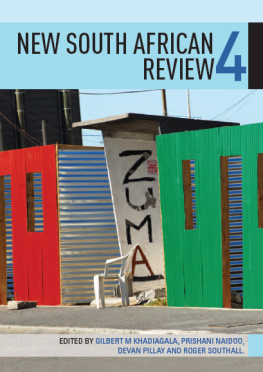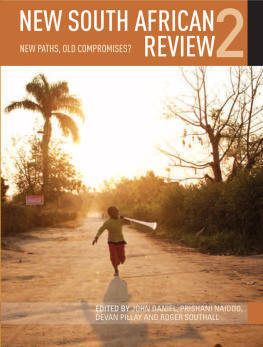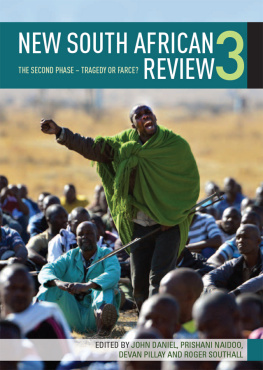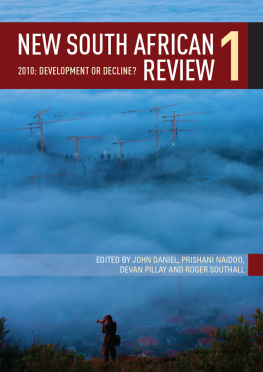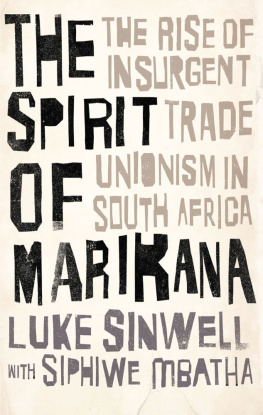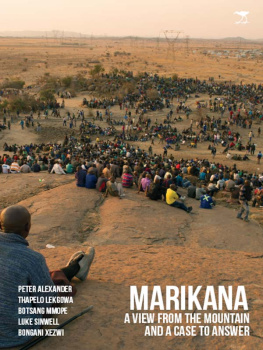Contents
NEW SOUTH AFRICAN REVIEW 5
BEYOND MARIKANA
EDITED BY GILBERT M KHADIAGALA, PRISHANI NAIDOO, DEVAN PILLAY AND ROGER SOUTHALL
Published in South Africa by:
Wits University Press
1 Jan Smuts Avenue
Johannesburg
www.witspress.co.za
Published edition Wits University Press 2015
Compilation Edition editors 2015
Chapters Individual contributors 2015
First published 2015
Also available in digital formats
ISBN 978-1-86814-874-5(print)
ISBN 978-1-86814-877-6 (PDF)
All rights reserved. No part of this publication may be reproduced, stored in a retrieval system, or transmitted in any form or by any means, electronic, mechanical, photocopying, recording or otherwise, without the written permission of the publisher, except in accordance with the provisions of the Copyright Act, Act 98 of 1978.
Project managed by Monica Seeber
Cover photograph Mujahid Safodien
Cover design and layout by Hothouse South Africa
Printed and bound by Interpak Books
Preface
Beyond Marikana , the fifth edition of the New South African Review , continues to present informed, scholarly discussion and debate about key issues animating the South African experience. Produced between January 2014 and May 2015, this particular volume was shaped largely around the contention that there are significant political shifts underway in South Africa today, with several chapters tracing their fault lines to the 2012 massacre by police of striking mineworkers in a place called Marikana.
Although the third volume in the New South African Review series offered an analysis and critique of the various forces immediately implicated in the tragedy associated with Marikana, it could not have anticipated the kinds of political ructions that we have since witnessed, especially from within different parts of the African National Congress (ANC) Alliance. The fifth volume once again, then, consciously draws attention to Marikana, but this time asking what its effects and affects have been, and why it has had such an impact. In this way, Marikana becomes the starting point for a much broader discussion and debate about the potential for new political alliances and forms to emerge in the current context, a discussion that resonates globally in the wake of the political experiments of movements, such as Occupy Tahrir, Occupy Wall Street and the Spanish Indignados, and will hopefully continue in editions to come.
New South African Review 5 also offers close analyses of contemporary developments with regard to other aspects of, and issues affecting, South African society including corruption, the economy, the Constitution, and uranium poisoning as a by-product of the mining industry.
This volume would not have been possible without the generosity of all its authors, to whom we are extremely grateful. Thanks must also go to the team at Wits University Press who continue to provide excellent guidance, assistance, skill and support to us as editors, and ensure that there is a final product for us to share. Particular thanks to the Dean of Humanities, Professor Ruksana Osman; Head of the School of Social Studies, Professor Shahid Vawda; and the Strategic Planning and Allocation of Resources Committee (Sparc) Fund for their ongoing support of the New South African Review .
Gilbert M Khadiagala, Prishani Naidoo, Devan Pillay and Roger Southall
May 2015
INTRODUCTION: Political reconfigurations in the wake of Marikana
Prishani Naidoo
On the weekend of 13-14 December 2014, two significant political events took place in South Africa. At a hotel in Kempton Park near Johannesburg, a national peoples assembly was convened by unionists from the National Union of Metalworkers of South Africa (Numsa) together with other activists (both independent and from a range of political formations), in preparation for the launch of the United Front. At the University of the Free State in Mangaung, the Economic Freedom Fighters (EFF) held what it also billed as its first national peoples assembly. Both groups had emerged from dissatisfaction among Alliance members with the current leadership of the African National Congress (ANC). Both events borrowed, in the idea of the assembly, from the history of the struggle against apartheid and from contemporary experiments of collectives fighting against the various effects and manifestations of neoliberal policies around the world. It could, then, be argued that together they reflect a growing and deepening disappointment with, and critique of, existing political forms and practices that pass for democracy in South Africa today, and a desire for alternative ways of engaging collectively around common interests, needs and aspirations.
As I sat in the sea of yellow t-shirts in the Kempton Park assembly listening to presentations and discussions, Mangaung was also celebrating the first real mass exodus of young people from the ANC fold since 1994. They were coming together with other youth fed up with the limited choices available to them in their lives, to commit themselves to the building of a political alternative to the ANC.
For many of us, who had been part of earlier collectives that had mounted critiques of (and experimented with alternatives to) the ANC governments neoliberal trajectory since the 1990s, this could not be cynically written off as dj vu , as a much greater mass of people were beginning to find each other as comrades again, in a new cycle of struggle a new cycle that, as this Introduction and several chapters in this volume argue, finds its roots in the events that have come to be known as Marikana.
Almost three years have passed since the massacre of thirty-four striking mineworkers at Marikana by the South African police, and yet the event continues to hold profound significance in the political realm, the depth of its influences and effects perhaps only beginning to be felt and understood today. In August 2012, the name Marikana became etched in history and memory as a symbol of the willingness of the state to use brutal force against workers in protecting the interests of capital and of an uncompromising spirit of resistance (or refusal to concede) to the impositions of such power.
As images of the bloodshed flashed across television screens and newspapers, South Africans across the political spectrum were moved. In the first instance, as the starkness of the inequalities and dangers borne by Lonmin workers in sustaining South Africas richest economic sector (platinum) was revealed, moral outrage was expressed in various forms of public critique of the ANC, its leaders, Lonmins management and directors, and the police and in acts of solidarity and support for the communities affected by the massacre and its aftermath. The Introduction to New South African Review 3 provided one such critique, highlighting the contradictions within the ruling party and its Alliance, as well as among its leadership, made visible and undeniable by Marikana.
But beyond its laying bare of certain unmistakable facts about the life of the poor in post-apartheid South Africa and about the ANC, its leaders, big capital (and where their interests overlap), three years later why does Marikana continue to feature so prominently in our political engagements? And has it shaped contemporary approaches to politics in ways that hold the potential for new political imaginaries and practices to emerge?
As several chapters in this volume show, the events of August 2012 in Marikana produced significant shifts in the ruling party and its Tripartite Alliance, and can be seen to represent a questioning (and a failure) of corporatist frameworks of engagement that have become dominant since the 1990s as well as the industrial relations framework governing employment relations (particularly in the mining sector) since 1996. Coinciding with a spike in local-level protests made known by the media more popularly as service-delivery protests, the 2012 massacre also inspired a whole new wave of protests, the name Marikana resonating across the struggles of a diverse range of people from farmworkers to land occupiers to other mineworkers in the following years. It also refocused public attention on the appalling conditions of work and life as well as the continued generation and distribution of profits in the mining sector in particular the platinum belt, producer of most of the worlds platinum supplies and on the character of public order policing.



